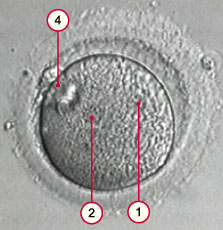|

|
|
|
4.6 The fertilization is complete.
The formation of the zygote
|
|
|
Introduction into the creation and development of the pronuclei
|
|
|
|
After the spermatozoon has impregnated the oocyte, i.e., has delivered the paternal portion of the genetic material, things are now set into motion within the oocyte so that the paternal as well as the maternal genetic information are put into a form that allows both to be brought together in a proper way. The unpacked DNA is enclosed in the slowly forming paternal and maternal pronuclei. During a synthesis phase the duplication of the DNA occurs in them.
After the synthesis phase, which takes almost a day, the DNA condenses into chromosomes. These promptly order themselves on the zygote's mitotic spindle so this can divide into the two-cell stage.
In the following, these processes are explained in greater detail.
|
|
|
|
The formation of the paternal pronucleus
|
|
|
Via the head of the spermatozoon an extremely thickly packed, haploid chromosome set (1n1C) has penetrated into the cytoplasma of the oocyte. This specially condensed DNA must be unpacked as a first step, i.e., decondensed. The protamines that are wrapped around the DNA strands are expanded and decomposed. With the help of enzymes and molecules from the cytoplasma the oocyte gradually expands the paternal pronucleus. A nucleic membrane encloses the decondensing DNA. The formation of a (pro)nucleus is necessary for the subsequent synthesis phase in which the DNA is duplicated.
|
|
|
| Fig. 44 - 4 hours after impregnation |
|
Fig. 45 - Impregnated oocytee at 4 h |
|
Legend |

1
2
3
|
Paternal pronucleus
Maternal pronucleus
Centrosome brought in by the spermatozoon |
|
|
|

|
|
Fig. 44
Schematic diagram four hours after impregnation. A nucleic membrane forms around both pronuclei. (In the pronuclei themselves a doubling of the DNA occurs at the decondensing chromosomes.)
Fig. 45
Snapshot roughly four hours after impregnation of the oocyte. The development of the pronucleus is now just partially recognizable.
|
|
Commentary
|
|
The maternal pronucleus is next to the polar bodies. The paternal one forms near where the sperm cell entered and is almost always some distance from the polar bodies.
|
|
|
|
|
Video
|
|
Video with generation of the pronucleus (166 kB).
© Dr. A. Senn, CHUV CEMCAV Lausanne
|
|
|
|
The formation of the maternal pronucleus
|
|
|
At the same time that the paternal pronucleus forms, the maternal pronucleus is also generated.
The penetration of the spermatozoon into the secondary oocyte instigated the resumption and termination of its second meiosis. After the 2nd polar body is created the maternal chromosomes that remain in the oocyte are enclosed by a nucleic membrane and decondensed.
|
|
|
|
Synthesis phase of the DNA in the pronuclei
|
|
|
The DNA must be duplicated before each commencing cell division so it can be distributed among the daughter cells. In an impregnated oocyte this happens for every chromosome set – the one from the father and the one from the mother – each in a separate pronucleus. The time needed for the duplication of the DNA amounts to roughly 12-18 hours. During this time span, the two pronuclei also get closer to each other spatially.
|
|
|
Commentary
|
|
Out of the 1n,1C of the spermatozoon 1n,2C are synthesized in the paternal pronucleus. From the 1n,1C remaining in the oocyte after the second meiosis, 1n,2C are made in the maternal pronucleus.
|
|
|
|
|

